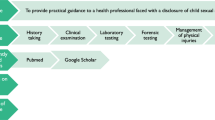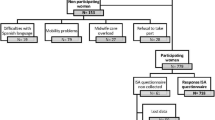Abstract
Objective:
The objective was to estimate the self-reported prevalence of domestic violence in a pregnant military population presenting for emergency care, and to determine the acceptability of domestic violence screening.
Study Design:
A prospective observational survey of patients presenting for obstetric emergency care. Women were anonymously screened for domestic violence using the Abuse Assessment Screen.
Result:
A total of 499 surveys were distributed, with 26 duplicate surveys. After excluding the 12 blank surveys, a total of 461 surveys were included in the final analysis. The lifetime prevalence of domestic violence (including physical, emotional and sexual abuse) was 22.6% (95% CI=19.0 to 26.4) with 4.1% (95% CI=2.3–6.0) of women reporting physical abuse in the past year and 2.8% (95% CI=1.3–4.3) reporting abuse since becoming pregnant. The majority of women 91.8% (95% CI=88.7–94.2) were not offended by domestic violence screening and 88.8% (95% CI=82.0–88.9) felt that patients should be routinely screened.
Conclusion:
The self-reported prevalence of domestic violence in a pregnant military population presenting for emergency care was 22.6%. Most women are not offended by domestic violence screening and support routine screening.
This is a preview of subscription content, access via your institution
Access options
Subscribe to this journal
Receive 12 print issues and online access
$259.00 per year
only $21.58 per issue
Buy this article
- Purchase on Springer Link
- Instant access to full article PDF
Prices may be subject to local taxes which are calculated during checkout
Similar content being viewed by others
References
Gazmararian JA, Adams MM, Pamuk ER . Associations between measure of socioeconomic status and mental health behavior. Am J Prev Med 1996; 12 (2): 108–115.
Ballard TJ, Saltzman LE, Gazmararian JA, Spitz AM, Lazorick S, Marks JS . Violence during pregnancy: measurement issues. Am J Public Health 1998; 88 (2): 274–276.
Gazmararian JA, Lazorick S, Spitz AM, Ballard TJ, Saltzman LE, Marks JS . Prevalence of violence against pregnant women. JAMA 1996; 275 (24): 1915–1920.
Norton LB, Peipert JF, Zierler S, Lima B, Hume L . Battering in pregnancy: an assessment of two screening methods. Obstet Gynecol 1995; 85 (3): 321–325.
Helton AS, McFarlane J, Anderson ET . Battered and pregnant: a prevalence study. Am J Public Health 1987; 77 (10): 1337–1339.
Parker B, McFarlane J, Soeken K . Abuse during pregnancy: effects on maternal complications and birth weight in adult and teenage women. Obstet Gynecol 1994; 84 (3): 323–328.
Bacchus L, Mezey G, Bewley S . Domestic violence: prevalence in pregnant women and associations with physical and psychological health. Eur J Obstet Gynecol Reprod Biol 2004; 113 (1): 6–11.
Campbell JC, Pugh LC, Campbell D, Visscher M . The influence of abuse on pregnancy intention. Women Health Iss 1995; 5 (4): 214–223.
Amaro H, Fried L, Cabral H, Zuckerman B . Violence during pregnancy and substance use. Am J Public Health 1990; 80 (5): 575–579.
Berenson A, Striglich N, Wilkinson G, Anderson G . Drug abuse and other risk factors for physical abuse in pregnancy among White non-Hispanic, Black, and Hispanic women. Am J Obstet Gynecol 1991; 164 (6, part 1): 491–499.
Campbell J, Poland M, Walker J, Ager J . Correlates of battering during pregnancy. Res Nurs Health 1992; 15 (3): 219–226.
Martin SL, English KT, Clark KA, Cilenti D, Kupper LL . Violence and substance abuse among North Carolina pregnant women. Am J Public Health 1996; 86 (7): 991–998.
McFarlane J, Parker B, Soeken K . Physical abuse, smoking and substance abuse during pregnancy: prevalence, interrelationships and effects on birthweight. J Obstet Gynecol Neonatal Nurs 1996; 25 (4): 313–320.
Stewart DE, Cecutti A . Physical abuse in pregnancy. Can Med Assoc J 1993; 149 (9): 1257–1263.
McFarlane J, Parker B, Soeken K . Abuse during pregnancy: associations with maternal health and infant birthweight. Nurs Res 1996; 45 (1): 37–42.
Bullock LF, McFarlane J . The birthweight-battering connection. Am J Nurs 1989; 89 (9): 1153–1155.
Jagoe J, Magann EF, Chauhan S, Morrison JC . The effects of physical abuse on pregnancy outcomes in a low-risk obstetric population. Am J Obstet Gynecol 2000; 182 (5): 1067–1069.
Neggers Y, Goldenberg R, Cliver S, Hauth J . Effects of domestic violence on preterm birth and low birth weight. Acta Obstet Gynecol Scand 2004; 83 (5): 455–460.
Shadigian E, Bauer ST . Pregnancy-associated death: a qualitative systematic review of homicide and suicide. Obstet Gynecol Surv 2005; 60 (3): 183–190.
Datner EM, Ferroggiaro AA . Violence during pregnancy. Emerg Med Clin North Am 1999; 17 (3): 645–656.
Bacchus L, Mezey G, Bewley S . A qualitative exploration of the nature of domestic violence in pregnancy. Violence Against Women 2006; 12 (6): 588–604.
Lutgendorf MA, Busch JM, Doherty DA, Conza LA, Moone SO, Magann EF . Prevalence of domestic violence in a pregnant military population. Obstet Gynecol 2009; 113 (4): 866–872.
Newby JH, Ursano RJ, McCarroll JE, Liu X, Fullerton CS, Norwood AE . Postdeployment domestic violence by US Army soldiers. Mil Med 2005; 170 (8): 643–647.
Brannen SJ, Bradshaw RD, Hamlin ER, Fogarty JP, Colligan TW . Spouse abuse: physician guidelines to identification, diagnosis, and management in the uniformed services. Mil Med 1999; 164 (1): 30–36.
Rentz ED, Martin SL, Gibbs DA, Sherrod M, Hardison J, Marshall SW . Family violence in the military. Trauma Violence Abuse 2006; 7 (2): 93–108.
Griffin WA, Morgan AR . Conflict in martially distressed military couples. Am J Fam Ther 1988; 16 (1): 14–22.
Cronin C . Adolescent reports of parental spousal violence in military and civilian families. J Interpers Violence 1995; 10 (1): 117–122.
Heyman RE, Neidig PH . A comparison of spousal aggression prevalence rates in US Army and civilian representative samples. J Consult Clin Psychol 1999; 67 (2): 239–242.
Newby JH, Ursano RJ, McCarroll JE, Liu X, Fullerton CS, Norwood AE . Postdeployment domestic violence by US Army soldiers. Mil Med 2005; 170 (8): 643–647.
McCarroll JE, Ursano RJ, Newby JH, Liu X, Fullerton CS, Norwood AE et al. Domestic violence and deployment in US Army soldiers. J Nerv Ment Dis 2003; 191 (1): 1–7.
Marshall AD, Panusio J, Taft CT . Intimate partner violence among military veterans and active duty servicemen. Clin Psychol Rev 2005; 25 (7): 862–876.
Datner EM, Wiebe DJ, Brensinger CM, Nelson DB . Identifying pregnant women experiencing domestic violence in an urban emergency department. J Interpers Violence 2007; 22 (1): 124–135.
Parker B, McFarlane J . Identifying and helping battered pregnant women. MCN Amer J Matern Child Nurs 1991; 16 (3): 161–164.
McFarlane J, Parker B, Soeken K, Bullock L . Assessing for abuse during pregnancy: severity and frequency of injuries and associated entry into prenatal care. JAMA 1992; 267 (23): 3176–3178.
Jasinski JL . Pregnancy and domestic violence. Trauma Violence Abuse 2004; 5 (1): 47–64.
Poole GV, Martin JN, Perry K, Griswold JA, Lambert CJ, Rhodes RS . Trauma in pregnancy: the role of interpersonal violence. Am J Obstet Gynecol 1996; 174 (6): 1873–1878.
Renker PR, Tonkin P . Women's views of prenatal violence screening. Obstet Gynecol 2006; 107 (2, part 1): 348–354.
Gielen AC, Campbell J, Garza MA, O’Campo P, Dienemann J, Kub J et al. Domestic violence in the military: women's policy preferences and beliefs concerning routine screening and mandatory reporting. Mil Med 2006; 171 (8): 729–735.
Chapin MG, Mackie CF . Research evidence to update practice guidelines for domestic violence screening in military settings. Mil Med 2007; 172 (7): ii–iv.
O’Reilly R, Beale B, Gillies D . Screening and intervention for domestic violence during pregnancy care: a systematic review. Trauma Violence Abuse 2010; 11 (4): 190–201.
MacMillan HL, Wathen CN, Jamieson E, Boyle MH, Shannon HS, Ford-Gilboe M et al. Screening for intimate partner violence in health care settings. JAMA 2009; 302 (5): 493–501.
Yost NP, Bloom SL, McIntire DD, Leveno KJ . A prospective observational study of domestic violence during pregnancy. Obstet Gynecol 2005; 106 (1): 61–65.
American College of Obstetricians and Gynecologists. Special Issues in Women's Health. ACOG: Washington, DC, 2005.
McFarlane J, Christoffel K, Bateman L, Miller V, Bullock L . Assessing for abuse: self report versus nurse interview. Public Health Nurs 1991; 8 (4): 245–250.
Webster J, Holt V . Screening for partner violence: direct questioning or self-report? Obstet Gynecol 2004; 103 (2): 299–303.
Canterino JC, VanHorn LG, Harrigan JT, Anath CV, Vintzileos AM . Domestic abuse in pregnancy: a comparison of a self-completed domestic abuse questionnaire with a directed interview. Am J Obstet Gynecol 1999; 181 (5, part 1): 1049–1051.
Family Violence Prevention Fund. National consensus guidelines on identifying and responding to domestic violence victimization in health care settings. http://www.endabuse.org/programs/healthcare/files/Consensus.pdf (accessed 18 February 2011).
McFarlane J, Soeken K, Reel S, Parker B, Silva C . Resource use by abused women following an intervention program: Associated severity of abuse and reports of abuse ending. Public Health Nurs 1997; 14 (4): 244–250.
Acknowledgements
Several of the authors are military service members. This work was prepared as part of their official duties. Title 17 USC 105 provides that ‘Copyright protection under this title is not available for any work of the United States Government.’ Title 17 USC 101 defines a United States Government work as a work prepared by a military service member or employee of the United States Government as part of that person's official duties. The Chief, Navy Bureau of Medicine and Surgery, Washington, DC, Clinical Investigation Program sponsored this study.
Disclaimer
The views expressed in this article are those of the author(s) and do not necessarily reflect the official policy or position of the Department of the Navy, Department of Defense, or the United States Government.
Author information
Authors and Affiliations
Corresponding author
Ethics declarations
Competing interests
The authors declare no conflict of interest.
Rights and permissions
About this article
Cite this article
Lutgendorf, M., Thagard, A., Rockswold, P. et al. Domestic violence screening of obstetric triage patients in a military population. J Perinatol 32, 763–769 (2012). https://doi.org/10.1038/jp.2011.188
Received:
Revised:
Accepted:
Published:
Issue Date:
DOI: https://doi.org/10.1038/jp.2011.188
Keywords
This article is cited by
-
Validity of the ACTS intimate partner violence screen in antenatal care: a cross sectional study
BMC Public Health (2021)



